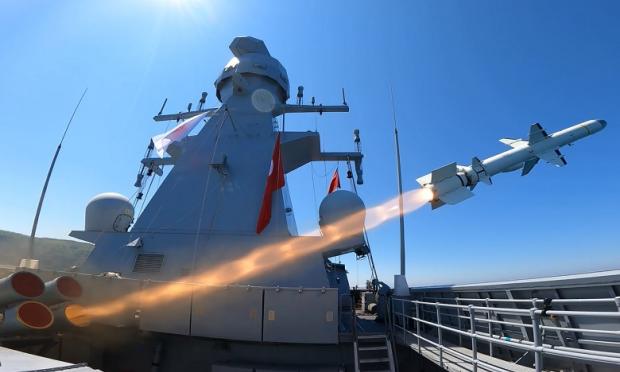Even after the devastating earthquakes and even though his country is going through a pre-election period, Erdogan continues unabated with the implementation of the Turkish armaments program, which is a clear indication of his intentions for Greek-Turkish in the event of his victory in the upcoming elections.
The Turkish planning-schedule
According to a reputable Turkish media on war industry matters, his country's Roketsan is preparing to launch the ATMACA missile from a submarine.
Director General Murat Iki conveyed the latest developments regarding the ATMACA missile that will be launched from the submarine.
Making statements on the matter he said: “Actually ATMACA is not a missile itself but is a family of products. In the first stage, it currently serves the Turkish navy as an anti-ship missile and there is a very serious demand for exports. There is a strong demand for ATMACA, especially from the Asia-Pacific region.
ATMACA is actually a family of products as we said, where together with its variants, it will contribute to the upgrade of Roketsan's product range.
The design phases of the underwater capsule-launched version of the ATMACA are about to end and we will begin testing this year.
It will be possible to launch cruise missiles against ships from submarines belonging to the Turkish Armed Forces.
Our goal is to produce all the guided munitions we need at sea, within Roketsan's current capabilities.
In addition to these, our AKYA torpedo began to serve our Naval Forces. After that, our ORKA torpedo will enter the Navy inventory. If you see it, Roketsan products, in the form of a family of products that will meet all the guided munitions needs of the Navy, will serve our Navy and the naval forces of friendly and sister countries.
ATMACA anti-ship missile
The ATMACA Anti-Ship Missile, developed by Roketsan, is Turkey's first national anti-ship missile. The ATMACA missile, which has a maximum range of 250+ kilometers, has an active radar, and has many advanced features such as sea-skimming.
It was developed under the needs of the Turkish Navy, and features "Advanced 3D Mission Planning".
Thanks to this feature, ATMACA operators can pre-plan the route it will take to its destination by adding route legs.
At the same time, the ATMACA, which has the KEMENT Tactical Data Link developed by Meteksan Defense, can update its track information even after launch.
Considering that the target enemy ship is behind an island in the "Sea of Islands", from its start, thanks to Super Sea Skimming, the ATMACA, will be able to circle the island in front of the target platform or to destroy the target by going up and down suddenly.
Since it has a low radar cross-section and can fly close to the surface of the water, the target can be detected by an enemy ship at a distance of 18-20 kilometers. Based on the ATMACA's speed of Mach 0.85, this gives the target ship's crew very limited reaction time.
For this reason, it is believed that the enemy vessel targeted by the ATMACA will not be able to eliminate it easily.
Finally, it is known that the Turks are attempting to develop "versions" of the ATMACA, from land to land.
Characteristics of the missile
• Autonomous operation
• Low radar footprint
• High sensitivity
• Can work in all weather conditions
• Resistant to Antidotes
• Update target, reattack, ability to cancel mission with data connection
• 3D Mission Plan
• Launch from surface and underwater platforms at land and surface targets
• Engagement from surface platforms to surface targets
• Target selection
• Long range
Technical specifications
Length 4,800 - 5,200 mm
Weight < 800 kg
Range > 220 km
Inertia guidance
Navigation System + Global Positioning System + Barometric Altimeter + Radar Altimeter
Warhead Type High Penetration Warhead , Warhead Weight 25kg, Seeker Active RF
What is changing in the Aegean?
The Turks are trying to create with the ATMACA in the Aegean, conditions of area denial (area denial) in parts of the Aegean or even denial of access (anti-access) to a large part of the Archipelago, for our Navy.
Denial of access or anti-access is defined as "the capabilities, usually of long range, designed to prevent an opposing force from entering a maritime area of operations".
Area denial is defined as "capabilities, usually of shorter range, designed not to prevent a force from entering, but to limit freedom of action within the maritime area of operations".
In general, the most important Anti Access capabilities include the ability to launch missiles of all ranges from surface ships, submarines, aircraft and coastal arrays.
Long-range ISR (Intelligence, Surveillance & Reconnaissance) systems suitable anti-satellite countermeasures, cyber and extended electronic warfare capability and special mission teams to destroy the enemy force's naval and air bases.
The Area Denial capability includes an extensive area and theater air defense network, short- and medium-range anti-ship missiles, conventional anti-ship missiles, precision weapons, chemical and biological warfare capability, minelaying, small high-speed craft, and extensive use of UAVs.
In closing, we point out that a reputable Turkish twitter on defense industry issues states:
"If the ATMACA coastal defense system, developed by Roketsan, is deployed on the coasts in the form of 7 separate arrays, the area of influence to be achieved is shown below.
The ATMACA coastal defense system will be able to penetrate 60% of the Black Sea and 85% of the Aegean"



